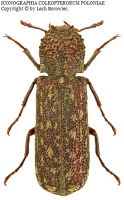Підтримуємо Вільну Україну
 We Support Free Ukraine
We Support Free Ukraine

Biodiversity Map
Taxa

Taxon count: 5
-
Lichenophanes variusSet as tree root ↑
Show taxon data → ⚑ [10] → Show taxon data
[10] → Show taxon data -
Apate gallicaSet as tree root ↑
Show taxon data → → Show taxon data -
Apate variaSet as tree root ↑
Show taxon data → → Show taxon data -
Apate variusSet as tree root ↑
Show taxon data → → Show taxon data -
Bostrichus dufouriiSet as tree root ↑
Show taxon data → → Show taxon data
-
Arthropodaphylum
Click to switch
to select orders
and filters > -
Hexapodasubphylum
Click to switch
to select orders
and filters > -
Insectaclass
Click to switch
to select orders
and filters > -
Coleopteraorder
Click to set
as the main taxon
and as a base
← of the left panel > -
Polyphagasuborder
Click to set
as the main taxon
and as a base
← of the left panel > -
Bostrichiformiaseries
Click to set
as the main taxon
and as a base
← of the left panel > -
Bostrichoideasuperfamily
Click to set
as the main taxon
and as a base
← of the left panel > -
Bostrichidaefamily
Click to set
as the main taxon
and as a base
← of the left panel > -
Bostrichinaesubfamily
Click to set
as the main taxon
and as a base
← of the left panel > -
Bostrichinitribe
Click to set
as the main taxon
and as a base
← of the left panel > -
Lichenophanesgenus
Click to set
as the main taxon
and as a base
← of the left panel >
species:
Lichenophanes varius
PL
YES
name status: valid name
BioMap ID: 1016573
taxon code: 3112
taxonomy checked: YES
Polish Red List: CR
source of names: Löbl et Smetana 2007
Data on distribution in Poland

Statistics
- Records: 10
- Publications: 3
- Collections: 2
- Publication authors: 5
- Illustrations (iconography): 1
- Photos (specimen/observation): lacking
Taxon description
Gatunek rozsiedlony głównie w południowej części Europy, skąd izolowanymi stanowiskami dociera do Europy Środkowej, notowany poza tym z Afryki Północnej, Kaukazu, Syrii, Turkiestanu i Iranu. W Polsce jest chrząszczem nadzwyczaj rzadkim, znanym dotychczas tylko z jednego stanowiska na Dolnym Śląsku. Postacie dojrzałe pojawiają się w maju i czerwcu; prowadzą skryty sposób życia w ciągu dnia, kryjąc się w szczelinach drzewa, pod odstającą korę lub w chodniki wyjściowo innych chrząszczy. Samice składają jaja w szczeliny martwego drewna drzew liściastych, zwłaszcza starych buków, dębów, topoli i lip. Larwy żerują w twardym i zmurszałym drewnie, drążąc chodniki w różnych kierunkach do głębokości około 2 cm. Po przezimowaniu przepoczwarczają się w końcu kwietnia i w maju. Stadium poczwarkowe trwa koło dwu tygodni.
Illustrations
... browse
 Lichenophanes
Lichenophanesvarius
External data sources
- Ostatnie rekordy
-
1075714
 ⊡
⊡ Bostrichidae: Lichenophanes varius, IR, Golestān, Alma Gol ad Tengli, 2015, leg. A. Lasoń
Bostrichidae: Lichenophanes varius, IR, Golestān, Alma Gol ad Tengli, 2015, leg. A. Lasoń -
1070310
 ⊡
⊡ Bostrichidae: Lichenophanes varius, AZ, Talysh Mountains, Yardımlı rayonu, ad Yardımlı, 2013, leg. A. Lasoń
Bostrichidae: Lichenophanes varius, AZ, Talysh Mountains, Yardımlı rayonu, ad Yardımlı, 2013, leg. A. Lasoń -
1070238
 ⊡
⊡ Bostrichidae: Lichenophanes varius, AZ, Talysh Mountains, Yardımlı rayonu, ad Yardımlı, 2013, leg. A. Lasoń
Bostrichidae: Lichenophanes varius, AZ, Talysh Mountains, Yardımlı rayonu, ad Yardımlı, 2013, leg. A. Lasoń -
1068091
 ⊡
⊡ Bostrichidae: Lichenophanes varius, AZ, Talysh Mountains, Yardımlı rayonu, ad Yardımlı, 2013, leg. A. Lasoń
Bostrichidae: Lichenophanes varius, AZ, Talysh Mountains, Yardımlı rayonu, ad Yardımlı, 2013, leg. A. Lasoń -
1067619
 ⊡
⊡ Bostrichidae: Lichenophanes varius, AZ, Talysh Mountains, Yardımlı rayonu, ad Yardımlı, 2013, leg. A. Lasoń
Bostrichidae: Lichenophanes varius, AZ, Talysh Mountains, Yardımlı rayonu, ad Yardımlı, 2013, leg. A. Lasoń -
1055500
 ⊡
⊡ Bostrichidae: Lichenophanes varius, AZ, Talysh Mountains, Yardımlı rayonu, ad Yardımlı, 2010, leg. A. Lasoń
Bostrichidae: Lichenophanes varius, AZ, Talysh Mountains, Yardımlı rayonu, ad Yardımlı, 2010, leg. A. Lasoń -
1055424
 ⊡
⊡ Bostrichidae: Lichenophanes varius, AZ, Talysh Mountains, Yardımlı rayonu, ad Yardımlı, 2010, leg. A. Lasoń
Bostrichidae: Lichenophanes varius, AZ, Talysh Mountains, Yardımlı rayonu, ad Yardımlı, 2010, leg. A. Lasoń -
479784
 ×
× Bostrichidae: Lichenophanes varius, PL, coll. ISEZ PAN
Bostrichidae: Lichenophanes varius, PL, coll. ISEZ PAN -
180782
 ×
× Bostrichidae: Lichenophanes varius, PL, «Śląsk» (Dominik 1958a, Burakowski et al. 1986c)
Bostrichidae: Lichenophanes varius, PL, «Śląsk» (Dominik 1958a, Burakowski et al. 1986c) -
180781
 ×
× Bostrichidae: Lichenophanes varius, PL, Dolny Śląsk (Capecki 1969, Burakowski et al. 1986c)
Bostrichidae: Lichenophanes varius, PL, Dolny Śląsk (Capecki 1969, Burakowski et al. 1986c) - ... more
- Powiązane publikacje
-
Burakowski B., Mroczkowski M., Stefańska J. 1986c. Chrząszcze – Coleoptera. Dermestoidea, Bostrichoidea, Cleroidea i Lymexyloidea. Katalog Fauny Polski, XXIII, 11, Warszawa.
 Show records
Show records -
Capecki Z. 1969. Owady uszkadzające drewno buka zwyczajnego (Fagus silvatica L.) na obszarze jego naturalnego zasięgu w Polsce. Prace IBL, 367:3-166.
 Show records
Show records -
Dominik J. 1958a. Część XIX. Chrząszcze – Coleoptera. Kapturnikowate – Bostrychidae. Klucze do Oznaczania Owadów Polski, 24, 39-40, Warszawa.
 full text
full text Show records
Show records
- Powiązane zbiory
-
ISEZ PAN
 Show records
Show records -
Lasoń A.
 Show records
Show records



